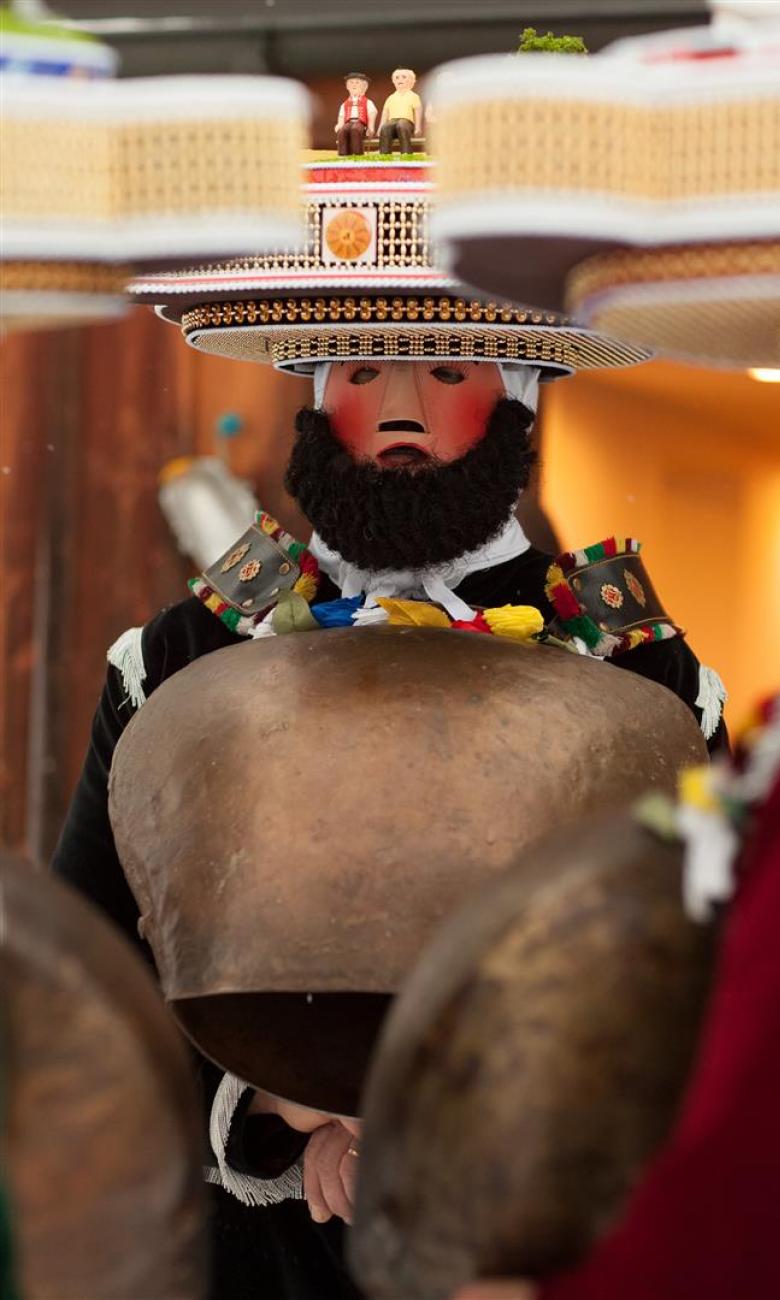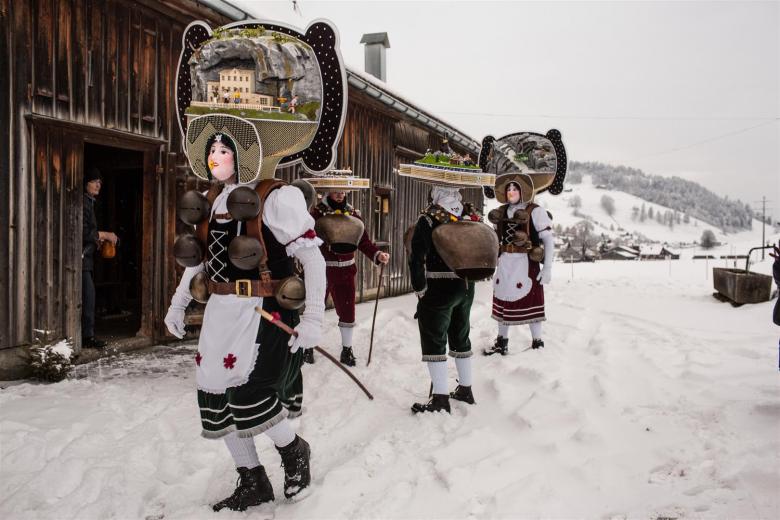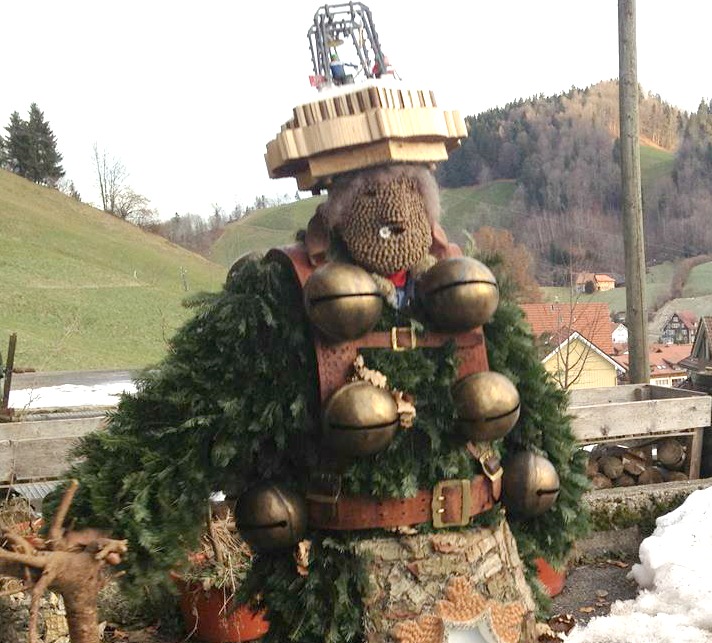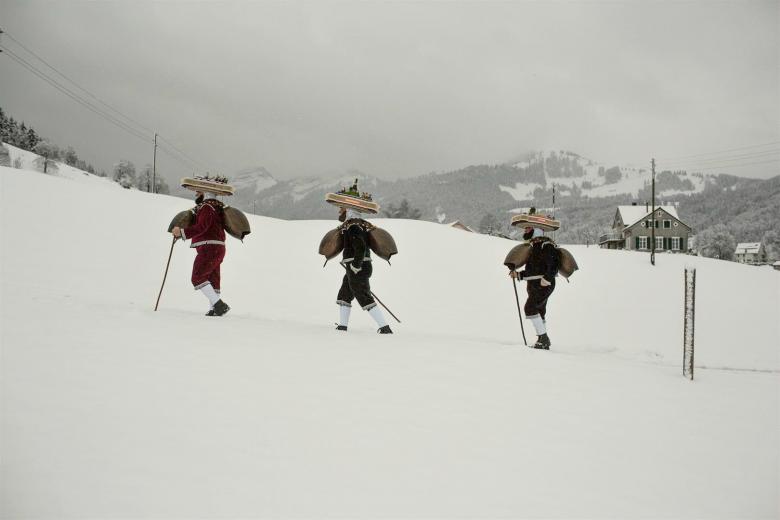Urnäsch’s magical ‘double New Year’s Eve’
The Silvesterchläuse of the village of Urnäsch in the Swiss canton of Appenzell Ausserrhoden celebrate the New Year twice. It is an old tradition going strong again.
In the early hours of the morning of 13 January, crowds will fill Urnäsch village square – just as they did on 31 December. When the clock strikes 5am, all the lights go out and everyone waits in silence for the Silvesterchläuse – groups of men dressed in robes and masks, the bells on their costumes ringing out as they make their arrival. The second leg of Urnäsch’s magical ‘double New Year’s Eve’ can begin.
Urnäsch – situated one hour and thirty minutes by train from Zurich, and with just over 2,000 inhabitants – has two New Year’s Eves: a first on the conventional Gregorian date of 31 December; and a second on 13 January in accordance with the Julian calendar, which the villagers of Urnäsch used until the 19th century.

Bells
The Chläuse start to make their way around the village in the morning. In groups, or Schuppel, they move from farm to farm and house to house to wish residents a Happy New Year. Watching the first of these Schuppel arrive is a joy to behold. The procedure is always the same. Each group is normally composed of six men, led by a Vorrolli. In the middle come the Schelli, while the Noerolli brings up the rear. The Vorrolli and Noerolli wear 13 large round bells fixed on padded leather harnesses that are strapped to their waist, back and shoulders. The other four members of the group wear cowbells.

Extraordinary headdresses
There are three different types of Schuppel. Firstly, we have the Wüeschte (ugly ones), who stand out particularly on account of their horned masks as well as their clothing made of fur and foliage. Next come the Schö-Wüeschte (beautiful ugly ones) – also referred to as Waldchläuse (‘woodland Chläuse’) or Naturchläuse (‘nature Chläuse’) – who festoon their costumes with items such as foliage, pine cones, pine branches, moss, and even snail shells. J.R.R. Tolkien, whose literary characters include the Ents, those tree-like forest-dwelling beings from Middle Earth, would certainly have appreciated the Schö-Wüeschte. Finally, the Schöni (pretty ones) are probably the most popular among those who witness the spectacle for the first time; some are dressed as women (Wiiber), with masks that look like the faces of porcelain dolls, while others (Mannevölcher) wear men’s clothes and bearded masks. On their heads are resplendent headdresses, adorned with wooden miniatures depicting Alpine village scenes, pastures, herdsmen, cows, and even modern still lives such as aerodromes and ski resorts – a captivating sight for young and old. Framed with beads and sequins, they shine in the dark thanks to LED lighting – a helpful touch of modernity. All the members of the group will have spent hundreds of hours preparing their costumes, while each elaborate headpiece is used for two to three years.


Once they arrive in front of a house, the Schuppel ring their bells, move to a rehearsed choreography, and perform a Zäuerli – the traditional Ausserrhoden wordless yodel – three times. Of around a thousand existing yodels, 30 or so are still sung today. In return, the Chläuse receive mulled wine or tea, which they drink with a straw through their masks, as well as a token sum of money to send them on their way.
Like father, like son
The day is long – and the costumes heavy, weighing between 20 and 30 kilos. It is as if the region’s cultural fabric is symbolically interwoven into each one. The groups choose the houses and farms they are going to visit. Poignantly, many of the older villagers who open their door to them used to be Chläuse themselves. “The loveliest thing every year is being able to visit people and see the joy – and tears – in their eyes,” says Walter Frick, who also admits to having shed the odd tear behind his own mask. By end of the day, the Chläuse are in a tired, emotional, almost trance-like state under the weight of their costumes as they move from house to house.

Walter Frick is a long-time member of the Waisenhausschuppel, a Schöni group that he and his brothers founded many years ago. The siblings grew up on a local farm and learned to yodel while milking the cows. Frick wore his first costume at the age of four. The young boy quaked in his boots in the presence of so many larger Chläuse towering above him – an experience that inspired this year’s publication of Wälti wird Silvesterchlaus, a children’s book illustrated by his wife. Frick is enthusiastic about upholding this old tradition which he knows and indeed likes talking so much about. Besides yodelling, making music and wearing costumes, he also works at the Appenzeller Brauchtumsmuseum (museum of local customs) in Urnäsch. The exhibits there include a selection of historic costumes which, although less elaborate than today’s versions, showcase the ingenuity and creativity of the people who used to wear them.
The first written reference to the Chläuse dates back to 1663, when the clergy condemned the ritual as being unchristian but failed to have it banned. The origins of the Chläuse are a mystery; some believe that they are derived from St Nicholas, while others see them as a means of scaring away bad spirits. After declining during the post-war period, the tradition has enjoyed a revival in recent decades and is now going arguably as strong as any other quintessentially Swiss custom. As such, it is also draws tourists from Switzerland and around the world, whose presence is an accepted part of the annual event, even if some locals are more happy about this than others. The singing and chanting that continues throughout the evening in the restaurants in and around the village are a particular attraction. Urnäsch currently boasts around 30 Schuppel, of which some half a dozen are composed of young boys.




